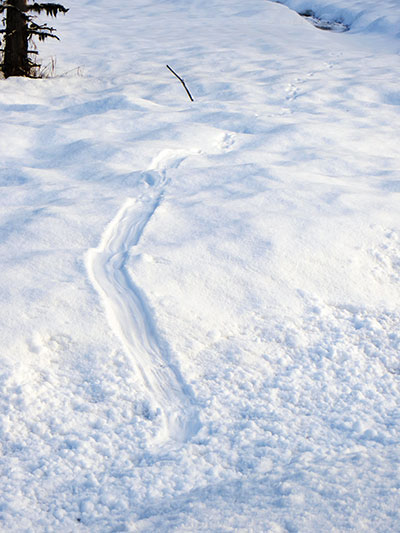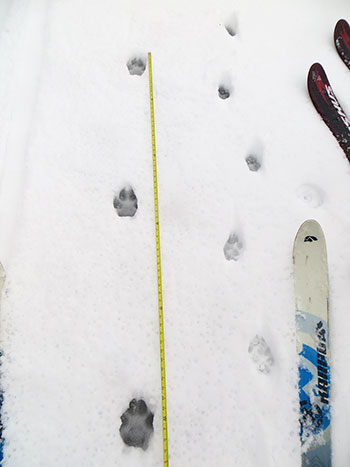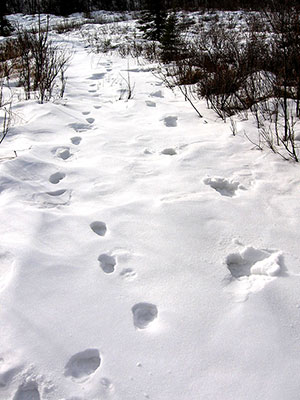Alaska Fish & Wildlife News
December 2013
Impressions in the Snow
Winter Tracking in Alaska

These signs and symbols left in mud, sand, leaves, and snow represent proto-alphabets. Often smeared, fragmented, and confused by weather, time, and other animals, these cryptograms were life-and-death exercises in abstract thinking. This skill, the reading of tracks in order to procure food, or identify the presence of a dangerous animal, may in fact be “the oldest profession”.
—John Vaillant, The Tiger
Reading the White Book
In his 2010 book The Tiger, author John Vaillant describes the ability of the forest dwellers of the remote Russian taiga to read tracks and sign in the snow as “reading the white book.” He weaves this theme throughout this true tale as the main characters track - and are tracked by - a man-eating Amur tiger. The letters, the sentences, the paragraphs and the stories are written by the animals in the forest. The question is: can you read this language?
Sense of Place
While we may not all be out tracking man-eating tigers, knowing our place and what creatures we share it with seems to be an almost universal desire. But not everyone is born in the forest and raised learning its language as a matter of survival. It can be challenging to learn this language and interpret what you see out there. It is easy to pass by tracks and sign and miss a story, even if you are keenly interested. You might walk past a set of fox tracks in your yard, or perhaps the tracks of a pack of wolves crossing a ski trail, and never be the wiser. The good news is that this language can be learned and it can be a rewarding experience that will keep you busy outdoors for a lifetime.
The New Tablet
Each year in Alaska the snow falls and suddenly animal tracks appear everywhere. The cat that hunts near your house every night is now betrayed by its tracks. The voles living under your woodshed leave clear evidence of their travels, and the erratic trails of the ermine are revealed. The birds picking at birch seeds on the ground leave intricate patterns that distinguish their species.
Plain and simple, tracks (disturbances) are easier to see in the snow than on hard ground or vegetated ground. Following animals is easier in the snow. That is why tracking an animal in the snow is considered simple tracking, because usually all of their tracks are visible. Contrast this to tracking an animal in the summer when you are following a string of signs with an occasional visible track thrown in there. That is the realm of systematic and/or speculative tracking.
But is it really that easy?
The short answer to that question is no. Seeing disturbances in the snow is relatively easy, yes, but determining what made those disturbances requires a lot of wildlife and nature knowledge. If you don’t have a solid foundation of animal track morphology and gaits without snow, it is not going to be any easier determining species with snow. In fact it may be more difficult because in many snow conditions you aren’t going to see any track at all. And a set of animal tracks in the snow may not appear like what you had in mind at all!
I can’t tell you how many times I have pointed at a set of tracks in the powdery snow, waiting for a response regarding what species passed by, only to be stared at with blank expressions. When people think about tracks in the snow, they think they are going to see crystal-clear tracks of an animal, and they might if the snow conditions are correct, but often it is just a set of disturbances. But they are really disturbances with a repeated pattern.
Animal Gaits
An animal gait is the way in which an animal moves: it is not a description of a specific track pattern. Each gait has numerous track patterns, depending on the speed and behavior of the animal, as well as the physiology of the animal (Mammal Tracks and Sign, Mark Elbroch, 2003).
Understanding animal gaits and recognizing track patterns is an absolute must for reading the stories in the snow. As I mentioned, in powdery, sometimes deep snow like we have in Interior Alaska, you rarely see clear animal tracks. The animals do leave tracks, but the snow is so loose that it immediately partially fills with snow. In addition, some of our species have heavily furred feet which cover their toe pads during the wintertime.

Each animal has a commonly used gait under normal circumstances, but each animal is capable of employing any gait. A marten, for example, almost always utilizes a 2x2 lope when in deep snow, but a marten will also use a diagonal walk in snow when moving slowly to investigate something. This can throw someone off if they have not seen it before. When you see a walking pattern, marten is not what comes to mind.
Conceptually, animal gaits can be difficult to grasp. Most animals leaving tracks in our snow have four feet (birds of course have only two) yet they may only leave a single line of tracks. Or all four feet may only leave two tracks beside each other. That is because the hind feet of an animal are often stepping directly where their front feet did. Many animals also bound or lope in the snow in which case they are leaving a disturbance created by four feet, separated by a gap, and then another disturbance where they land again, over and over and over. The size of the groups and the length of the gap between them depend on what animal created them under what conditions.
The most common gaits used by animals include:
Walking is an easy pace in which each foot moves independently. It is commonly use by deer and moose, members of the cat family and wide bodied animals such as beavers, porcupines and bears.
Trotting is faster than a walk. Opposite side front and hind legs move together. Canines, shrews, voles and other species commonly trot when they need to move faster than a walk.
Lopes and Gallops are the fastest gaits. Lopes are used by most members of the weasel family as their natural gait.
Hops and Bounds are characterized by an animal pushing off with both hind feet at the same time. They are used by hares and many rodents.
You must learn these gaits and understand them if you want to know what is happening out on the snowscape. Also, if you can’t determine what the animal is by the gait or tracks, follow it for a while. You will find other evidence: scat, a kill site or maybe a clear track. Often you can find a clear track under spruce trees where the snow may be less deep.
I followed a trail of tracks in powdery snow that I thought were coyote but they could have been a large fox extending its stride a bit (a female coyote and a male fox are getting close in stride lengths), so I followed it until it reached a snow-packed logging road where I found a clear track. It was a coyote (coyote and fox tracks are very different- not so much in size as in all of the other features such as pad size, shape and placement, inter-pad spacing, shape of the carpal pads, amount of hair under feet, etc.). There really is no substitute for investigation and reinforcement in the field.
Direction of travel
Even with an animal that does usually leave clear and obvious prints in the snow (such as a snowshoe hare) about half the people I ask (all ages) determine the wrong direction of travel for this animal. Surprisingly, direction of travel can be difficult to determine in powdery snow as you may not see a clear track within the depression created by the animals’ foot. Sometimes reaching into the depression and feeling the bottom can give you a clue as to which way the track was laid in there, especially with hoofed animals. Another method of determining direction of travel is the look at the depression in the snow created by the foot and leg of the animal. The hole will often have a three-part shape: a smaller entrance hole where the foot went into the snow, a narrow section where the leg pivoted as the animal moved forward, and a larger exit hole where the animal retracted its foot. And yet another way to tell direction of travel is to look for snow throw. Crumbles of snow are generally thrown forward of the track disturbances in the snow. You can see snow throw from a distance and if you practice you can easily judge direction of travel of a snow trail.
How old is the track?

Aging tracks in general is all tied to meteorology. You must know the local weather conditions for a given period of time in order to age tracks. Of course, if it snows and you go outside after the snow and see tracks then you can easily narrow down the time. But otherwise, depending on your location, in the winter it can be very difficult to age tracks. In the Interior when winter is cold and there is no solar input and no wind to affect a track, they can remain fresh looking for days and days. If there is solar input that starts to melt the crisp edges of a track, or wind that rounds out the crisp edges then the weather can give you many clues as to aging.
There is a way to determine if a track is really fresh, however. The physical properties of snow help us on this. When snow is disturbed (i.e. something walks through it) pieces are broken and thrown on top of the snow around it. After a time, the crumbles of snow that are thrown on top of the other snow will bond (this is called sintering – it is the same principle that allows us to make snow shelters). The temperature and the humidity and type of snow will determine how long this process takes. I have seen crumples of snow bond to the blanket of snow in half an hour for example. It might take 20 minutes or it might take an hour. You need to practice and learn this for varying conditions.
In a practical sense, when I am out hunting and I see hare or ptarmigan or moose tracks, and I kneel down and blow on the snow crumples, if they blow away I get excited because I know that animals are likely very close. If the crumples have sintered and don’t blow away, well the tracks are older and I need to figure out how much older – even so, the animals could still be near.
Practice
I’ve heard people say, “Oh, I have already taken a track class before,” indicating that believe they don’t need to take another. Or, “I know what lynx tracks look like.” But do you know what a lynx track looks like when only half of it is showing, or the snow is deep and powdery and there are no tracks, just impressions? Or is that a grouse or a ptarmigan trail? Is that an ermine or a least weasel? Is that ermine carrying a vole in its mouth? What bird left these wing impressions?
There are infinite varieties of track clarity because there is infinite variation in substrate and weather conditions: one inch of snow is not the same as two. There is powdery snow, hard snow, wet snow and it goes on and on. So the bottom line is that if you want to learn to Read the White Book you have to get out and start learning the alphabet. Over time, for the rest of your life perhaps, you can practice, and you will still be learning. There will always be the opportunity to be challenged and even baffled. The more you know, the more you can read and interpret. So there really is no end to this story.
Mike Taras is the ADF&G Wildlife Education and Outreach Specialist for Interior and Northeast Alaska. Mike is certified as a Tracker III through Cybertracker Conservation (the only organization in North America that evaluates wildlife trackers). He has been evaluated in wildlife track and sign identification as well as animal trailing across the U.S. and in South Africa.
Some resources to help you learn:
There are many books out there on the subject of animal tracks and sign. Mark Elbroch has the two most comprehensive contemporary guides but all of the other will help you learn as well.
Mammal Tracks and Sign, Mark Elbroch
Bird Tracks and Sign, Mark Elbroch
Field Guide to Tracking Animals in Snow, Louise R. Forrest.
Peterson Field Guides, Animal Tracks, Olaus J. Murie
* Educators can check out animal track kits and trail camera kits from ADF&G offices around the state.
Subscribe to be notified about new issues
Receive a monthly notice about new issues and articles.
